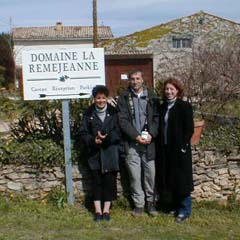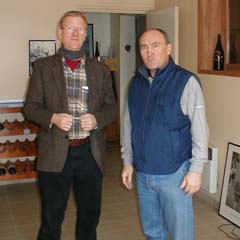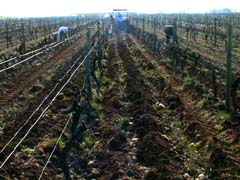Rhônesome and Ramblin’: In Search Of A Linear Narrative
Fanny Klein brought us coffee. She must have taken pity on us, that morning after. Fanny had agreed to be our translator for Sunday evening and Monday, giving me a chance to get my French “legs” under me, before I became our only link to any semblance of comprehension on this journey. Fanny’s father, Remy Klein, is the propietor of Domaine La Remejeanne, and he’d arrived chez Bouchard late Sunday evening, to retrieve his daughter, and have dessert!

The Kleins, from Remejeanne
The Domaine La Remejeanne is in the Departement du Gard, on the west side of the Rhône. It’s a hillside property, with rocky soils, and great eastern and southern exposures. The wines, which are of exceptional quality, have considerable depth, suave texture, and great freshness. The Kleins are truly lovely people, exemplars of a kindness and generosity of spirit that seemed to mark our entire trip. That Monday, over and above the coffee and the wonderful tour and tasting, Ouahi Klein, Fanny’s mother, took us to lunch in Bagnols-sur-Ceze, to a marvelous restaurant specializing in fish. Four days later the Geoffroy family at Chateau Thivin (Côte de Brouilly, in Beaujolais) included us in their family lunch at the chateau. The food and wine were sumptuous, of course, but the warmth and generosity carried by the invitation were most special.
In fact, when I’ve been asked, since my return, what my favorite part of the trip was, I never hesitate — it was the incredibly generous and kind treatment we were shown at every turn. Madame Chagny, at the very fine restaurant Cep, in Fleurie, bought our lunch on Saturday (we’d had a grand and gorgeous supper there the previous night, and I’d given her a bottle of Rocks and Gravel Saturday morning.) Alain Graillot bought our dinner one evening, as well, at Chaudron, a great, small restaurant in Tournon. The dinner included, among other wines, a superb bottle of 1991 Hermitage from my favorite producer, J.L. Chave. Chave is a master with Syrah; he’s peerless, both in the vineyard, and in the cellar. I was especially glad to have the chance to taste his wines with Ron Mansfield. We’d dined the previous evening at La Prieure in Villeneuve-les-Avignon, and drunk the 99 Chave estate St.Joseph. (At a dinner back home in Berkeley in late April, Ron also got to taste the white Hermitage from Chave, vintage 1993. Chave’s whites are every bit as impressive as his reds.)

Clos de l’Oratoire de St. Martin
All through our travels we were guests at many of the great addresses in both the Northern and Southern Rhône. The day of our visit at Remejeanne and Domaine Ste. Anne, (see Organolepticians #28) we finished up at Clos de l’Oratoire de St. Martin, in Cairanne, with Frederic Alary, whose wines are among the finest of that very fine appellation. The next day began with Paul Avril, one of the lions of Chateauneuf, whose son Vincent seems destined to fill his father’s large shoes with honor and grace. Clos des Papes, the Avril’s domaine, makes red and white wines that are generally regarded as perhaps the most elegant wines in Chateauneuf.
We had our first lunch at Verger des Papes (see Organolepticians #27) that same day, following a short and quite enjoyable tasting at Vieux Donjon, another of my favorites in Chateauneuf du Pape. It was also our first meal in a topnotch restaurant, at which we were not accompanied by a local winegrower, and it was hard not to imagine that we might be seen, for being American tourists, as largely ignorant of the local food and wine. So it was fun to be able to spot a wine on the list that could only interest someone (like me) with some feeling for the wines of the region, and some familiarity with the various producers, the best vintages, and a sense of the market. The wine was a 1990 Domaine du Haut des Terres Blanches, from Remy Diffonty (I have a case of the 89 in my cellar), a ravishingly silky, complex wine from an exceptional vintage that now had the benefit of nearly ten years bottle age, and was ridiculously inexpensive compared to the “big-name” bottles listed. It may just have been me, but it seemed that we were treated in a much more attentive manner after I ordered that bottle.

Les Dentelles du Montmirail
The following day began at Beaucastel, and included, as it had on my previous visit in 1990, a tasting of samples from the previous vintage’s vines that gave us an unblended look at each of a number of the various varieties grown in Chateauneuf: Roussanne, Grenache Blanc,Picardan, Cinsault, Grenache Noir, Counoise, Syrah, and Mourvèdre. Our last visit that day, before our dinner rendezvous in Tournon with Alain Graillot, was at the venerable Gigondas estate known as Les Pallieres. Pallieres is perhaps the most beautiful, magical, almost haunting wine estate I’ve visited anywhere. It was impossible to escape a sense of some grand, mysterious sort of presence there. Perhaps it was the proximity to the beautiful Dentelles du Montmirail, and the wildness of that setting. It was ever-so-slightly spooky, yet utterly wonderful.
Daniel Brunier, scion of the Brunier family that has operated the deservedly esteemed Chateauneuf du Pape estate known as Vieux Telegraphe, showed us around at Les Pallieres. Daniel is a marvelous young man, knowledgeable, passionate, and tremendously thoughtful — another extremely impressive son, who (like Vincent Avril, Jean Louis Chave, Jean Marie Clape) is stepping into the very large shoes worn by his father, Henri Brunier, another of the great figures of the region.

Les Pallieres

Les Pallieres, looking northwest
The wines at Les Pallieres have had, historically, a great reputation, but as the age of the former owner advanced, things slipped gradually into decline. Now, under the guidance of the Bruniers, things are looking up again. The 2000 Pallieres, if my tasting on our visit is any indication, is one of the most impressive wines I’ve ever tasted from the Southern Rhône (or anywhere else).

Steve Edmunds and Alain Graillot

Graillot’s vineyard, Crozes Hermitage
That day (Wednesday) had been the first day on the trip that the Mistral hadn’t blown; it was a lovely day, though a bit on the cool side. Alain Graillot told us that evening at dinner that it would be extremely cold that night, and early the next morning, and that the frost danger would be very high. Faced with the risk of losing their crops for the year, the vineyardists and orchardists (remember, the peaches, pears and cherries were in bloom) would be burning fires overnight, using anything combustible they could get their hands on (“they’ll even burn tires!” Alain told us), to keep the frost from damaging their crops.
So we awoke Thursday morning to very heavy skies blackened for miles and miles in every direction by the heavy shadows of thick smoke. Alain’s vineyard, and the neighboring orchards were pretty much unscathed, but there were places that suffered some losses, the extent of which were not clear during our sojoun.
Alain is a fine man, and a terrific winemaker, and his wines, as usual, were a great delight. From his property, in Crozes-Hermitage, we travelled north to Côte Rôtie for visits with Patrick Jasmin, and the domaine of Guy Bernard, presided over by his two sons. Wines in both places are superb, really gorgeous wines. It was my first actual visit to Côte Rôtie, despite having drunk the wines from a number of its better producers over the last 30 years. It took being there to really understand what steep means. Hermitage looks steep (and is…) but Côte Rôtie is just ridiculous. To do the area justice, as a writer, I need to spend way more time there. It’s one of the most impressive wines on earth, and is not to be taken lightly or thoughtlessly. (It makes me pretty skeptical about the state of things when some of my colleagues here in the US, who’ve maybe made wine from Syrah grapes for a year or two, or maybe never before, decide they should charge 60, 80, 100 dollars for their wines, just because they want to. And every bit as skeptical when people decide to pay that much, when you can buy Côte Rôtie for, in many cases, less money. There is seldom any basis for comparison between the two types of wine.)

Tasting dans le cave, with Patrick Jasmin

The steep vineyards of Côte Rôtie
All in all, the trip to France with Ron was a great experience, and it was a treat for me to share with Ron my enthusiasm for the wines, the people, and the culture, and to have a sense that that enthusiasm was contagious, and he caught a fairly serious case of it. Who knows? Maybe I should become a guide?
We did go to Beaujolais the last couple of days, to learn more about the ins and outs of Gamay. Beaujolais is a kind of transition zone between the Rhône and Burgundy, and the very best wines from Beaujolais, the “cru” wines from Morgon, Moulin-a-Vent, Côte de Brouilly, etc., share certain traits with each of their neighbors to the north and south. It’s often said that great cru Beaujolais tastes more like Burgundy — more savory, more nuances, greater length, more ageability. Interestingly, they grow in granite, much more like their neighbors in the northern Rhône. My own experience has been that, while it’s true that I’ve had some Beaujolais that have made me think of Burgundy, aromatically I’ve found a much stronger affinity between Gamay and Syrah than between Gamay and Pinot Noir.

Looking south from Côte de Brouilly
Why does this matter? I love good Beaujolais. It is, at its best, a wine that brings sudden, simple joy to the soul. It’s utterly delicious, and it makes me glad to be alive. And, in 2002, thanks to a new planting undertaken by Ron Mansfield, we will begin producing our own version of such a wine, from the very same grape, grown at 3300 feet elevation in El Dorado County. With a bit of luck, you’ll be glad we did. Watch this space for details.
–Steve Edmunds

Ron Mansfield, in Chateauneuf du Pape